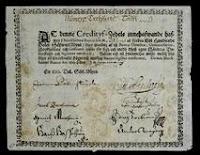 In November 1656, King Karl X Gustav of Sweden signed two charters creating two private banks under the directorship of Johan Palmstruch, a trade commissioner born in Riga. Palmstruch modeled the banks on those of Amsterdam where he had become a burgher. One bank offered clients a facility to deposit money and issue cheques; the other offered loans financed by short term giro deposits.
In November 1656, King Karl X Gustav of Sweden signed two charters creating two private banks under the directorship of Johan Palmstruch, a trade commissioner born in Riga. Palmstruch modeled the banks on those of Amsterdam where he had become a burgher. One bank offered clients a facility to deposit money and issue cheques; the other offered loans financed by short term giro deposits.In 1660 the copper content of Swedish coins was reduced prompting many of the banks' customers to demand their older coins, which were now worth more as scrap metal than as currency. Since the money had already been lent out, the bank did not have enough coinage to fulfill these requests. Faced with this liquidity problem, Palmstruch's solution was to issue Europe's first banknotes that could be used as currency and exchanged for their value in coinage.
On 16th July 1661, Stockholms Banco issued the first set of Kreditivsedlar ('credit paper') in round denominations - 5, 25, 100 and 1000 kopparmynt. This financial innovation brought new pitfalls. The bank issued too many notes reducing their purchase value and leading to a flood of people wanting to exchange their notes for coins; however, the bank did not have sufficient coins to meet demand. The bank had no novel solution to this new liquidity problem, as a result it was liquidated in 1667.
Charged with irresponsible book-keeping Palmstruch was stripped of his title and sentenced to either death or exile. After the Swedish government reprieved the death sentence Palmstruch (now called Wittmacher) served a two-year prison sentence and died a year after his release.
Related posts
First banknotes issued in America: 3rd February 1690
The United States Mint established: 2nd April 1792
U.S. Congress authorised Two-Cent coin: 22nd April 1864